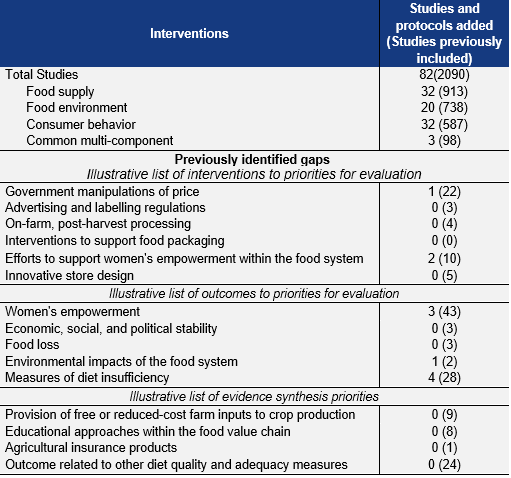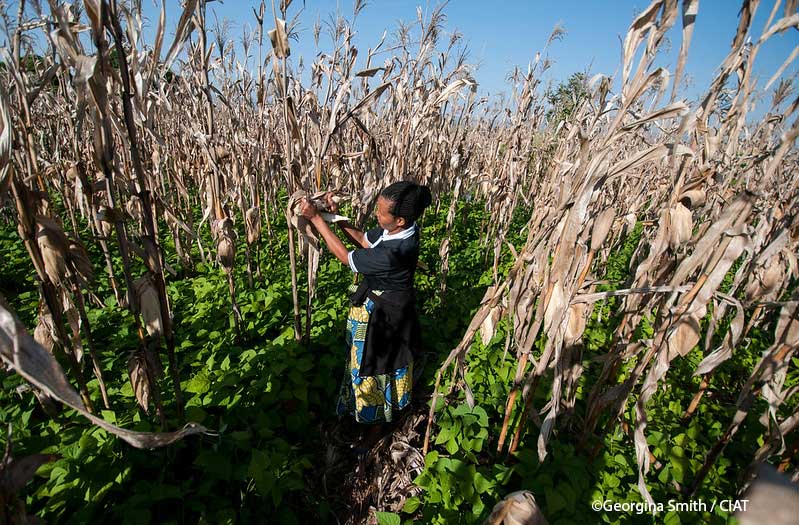As we've noted before on this blog, the world faces a critical need to revamp its food systems to provide healthy diets for a growing global population within the planetary boundaries. Making these changes means policymakers need to know what interventions work, for whom, and at what cost – and the state of knowledge about that question is changing rapidly.
With the release of our second update to the Food Systems and Nutrition Evidence Gap Map (EGM), originally published in early 2021, we have already identified 156 new studies beyond what was included in the original map. That figure represents about 8 percent of the total number of studies which have ever been conducted in the field, again emphasizing the relevance of turning it into a ‘living EGM’.
Much of the new research found for this update focuses on interventions related to consumer behaviour (n=32). In the past, this was the least studied intervention domain. However, in this update, it is evaluated as often as the food supply chain and more than food environment interventions (n=20).
The ‘living EGM’, supported by the GIZ “Knowledge for Nutrition” (K4N) program, presents all impact evaluations and systematic reviews of interventions in low- and middle-income countries that function within food systems and measure outcomes related to food security and nutrition. In order to ensure that our map represents the most current research, we have committed to updating the map regularly through March 2023.
The importance and utility of continuous surveillance
Given the size of the literature base, keeping the map updated has been a massive undertaking. In our first update, we screened almost 15,000 additional articles covering the period between September 2020 and July 2021, adding 74 relevant new reports to the map. For this second update, we integrated the continuous surveillance for the Food Systems and Nutrition EGM with the continuous surveillance we conduct for the Development Evidence Portal. Across these two projects, we screened over 86,000 reports from searches covering the period between July 2021 and January 2022, from which we added an additional 82 articles to our map. These figures illustrate the speed with which EGMs in rapidly-changing fields can become outdated and the need for continuous updates. We identified five new articles and three protocols in areas identified as key evidence gaps, giving researchers easier access to evidence that was previously unavailable.
We are also leveraging the Food Systems and Nutrition EGM to conduct two rapid evidence assessments: one on women’s empowerment within food systems, and one on taxes and subsidies to promote a healthy diet. These accelerated, systematic literature summaries respond directly to evidence gaps identified through the EGM. They are being conducted in a four-month timeframe, half of that of a traditional systematic review. The accelerated process is possible because they rely heavily on the search conducted for the surveillance of the EGM. While not quite as rigorous, they still follow many of the best practices of a systematic review: double screening at full text, data extraction by two independent reviewers, meta-analysis where possible, and contextualization with qualitative data.
The living EGM – recent additions
- We added 82 studies to the map. Several of them covered already well-studied interventions, like peer support and counsellors (n=16), classes (n=8), and supplement use or provision (n=10)
- In the past, consumer behaviour was the least studied domain; however, in this update, it has the same number of new studies as the food supply chain domain (n=32 each) and more than the food environment (n=20)
- Four studies (5 per cent) evaluated national or transnational level policies, mostly in China (n=3). This is a shift from 9 per cent in the original EGM.
- Five completed studies and three protocols address previously identified gaps: women’s empowerment (n=3), governmental manipulations of price (n=1), and measures of diet insufficiency (n=4).
- There continues to be a reduction in the reliance on experimental designs from 80 per cent to 67 per cent.
- The country focus largely returned to that of the original map, with the most commonly considered countries being India (n=11), followed by China (n=9), and Iran (n=7)
Table 1: New studies in areas previously identified as priorities for research
Further information on additions to the Food Systems and Nutrition EGM can be found here. If you are interested, you can find other publications related to the map here and the map itself here.













